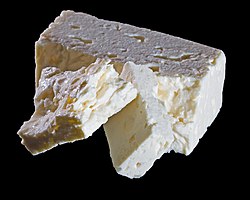Feta
| Feta | |
|---|---|
 |
|
| Source of milk | Sheep (≥70%) and goat per PDO; similar cheeses may contain cow or buffalo milk |
| Pasteurized | Depends on variety |
| Texture | Depends on variety |
| Aging time | min. 3 months |
| Certification | PDO, 2002 |
| Nutritional value per 100 g (3.5 oz) | |
|---|---|
| Energy | 1,103 kJ (264 kcal) |
|
4 g
|
|
|
21 g
|
|
|
14 g
|
|
| Vitamins | |
| Vitamin A | 422 IU |
| Riboflavin (B2) |
(70%)
0.84 mg |
| Pantothenic acid (B5) |
(19%)
0.97 mg |
| Vitamin B6 |
(32%)
0.42 mg |
| Vitamin B12 |
(71%)
1.7 μg |
| Minerals | |
| Calcium |
(49%)
493 mg |
| Sodium |
(74%)
1116 mg |
| Zinc |
(31%)
2.9 mg |
|
|
| Percentages are roughly approximated using US recommendations for adults. Source: USDA Nutrient Database |
|
Feta (Greek: φέτα, féta, "slice") is a brined curd white cheese made in Greece from sheep's milk, or from a mixture of sheep and goat's milk. Similar brined white cheeses produced in Europe are often made partly or wholly of cow's milk, and they are also sometimes called feta. It is a crumbly aged cheese, commonly produced in blocks, and has a slightly grainy texture. Feta is used as a table cheese, as well as in salads (e.g. the Greek salad) and pastries. Most notable is its use in the popular phyllo-based dishes spanakopita ("spinach pie") and tyropita ("cheese pie"), or served with some olive oil or olives and sprinkled with aromatic herbs such as oregano. It can also be served cooked or grilled, as part of a sandwich, in omelettes, or as a salty alternative to other cheeses in a variety of dishes.
Since 2002, "feta" has been a protected designation of origin product in the European Union. According to the relevant EU legislation, only those cheeses produced in a traditional way in particular areas of Greece, which are made from sheep's milk, or from a mixture of sheep's and up to 30% of goat's milk from the same area, can be called "feta". However, similar white-brined cheeses (often called "white cheese" in various languages) are found in the Eastern Mediterranean and around the Black Sea.
Feta is a soft brined white cheese with small or no holes, a compact touch, few cuts, and no skin. It is usually formed into large blocks, which are submerged in brine. Its flavor is tangy and salty, ranging from mild to sharp. Its maximum moisture is 56%, its minimum fat content in dry matter is 43%, and its pH usually ranges from 4.4 to 4.6. Feta is traditionally categorized into "firm" and "soft" varieties. The firm variety is tangier and considered higher quality. The soft variety is almost soft enough to be spreadable, mostly used in pies and sold at a cheaper price. When sliced, feta always produces a varying amount of trímma, "crumble", which is also used in pies; trímma is not sellable and is usually given away for free upon request.
...
Wikipedia
